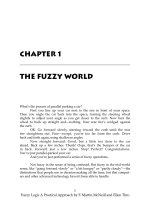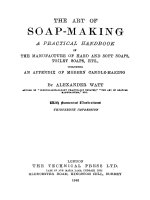Modeling of Combustion Systems A Practical Approach 7 pot
Bạn đang xem bản rút gọn của tài liệu. Xem và tải ngay bản đầy đủ của tài liệu tại đây (156.48 KB, 3 trang )
613
Appendix G
Kinetics Primer
Consider a general reaction:
or equivalently,
(G.1)
comprising r
i
moles of reactants R
i
and p
k
moles of products P
k
. Then we may
write a law of mass action as
(G.2)
If the sign is negative, then the reaction consumes the species with time
rather than produces them. We may also define the reaction rate for species
k as rr
k
:
(G.3)
where is the molar volume [L
3
/N] and the reaction rate has units of [N/L
3
].
For a constant volume (density) reaction, the equation reduces to
(G.4)
where the brackets indicate the molar concentration of the enclosed species.
rr pp
11 22 11 22
RR PP++↔++$$
rp
jj
j
m
kk
k
n
R
==
∑∑
↔
11
P
−=− = =
11 11
12 12
r
dN
dt r
dN
dt p
dN
dt p
dN
dt
R1 R2 P1 P2
$$
rr
r
V
dN
dt p
V
dN
dt
k
kk
=− =
11 11
ˆˆ
Rk Pk
ˆ
V
rr
r
d
dt p
d
dt
k
k
k
k
k
=−
⎡
⎣
⎤
⎦
=
⎡
⎣
⎤
⎦
11
RP
© 2006 by Taylor & Francis Group, LLC
614 Modeling of Combustion Systems: A Practical Approach
Usually, one defines a reaction coordinate known as the conversion (x
k
),
having the property that for species k the reaction starts at x
k
= 0 and ends
at x
k
= 1. The general definition is
(G.5)
where N
k,0
is the starting number of moles of species k, and N
k
is the con-
centration at some particular conversion of interest. Thus, N
k,0
is a constant
and N
k
is a variable. We may also write
(G.6)
For constant density, we have
,
where [k] is the concentration of species k, and [k
0
] is the starting concentra-
tion. We may write the conversion for any particular species and relate it to
any other species according to
(G.7)
Or in terms of a single conversion (say, x
R1
), we may write
(G.8)
For constant density, we may write
(G.9)
(G.10)
x
NN
N
k
kk
k
=
−
,
,
0
0
NxN
kkk
=−
()
1
0,
x
kk
k
k
=
⎡
⎣
⎤
⎦
−
⎡
⎣
⎤
⎦
⎡
⎣
⎤
⎦
0
0
kxk
k
⎡
⎣
⎤
⎦
=−
()
⎡
⎣
⎤
⎦
1
0
N
r
x
N
r
x
N
p
R
R
R
R
P10
1
1
20
2
2
10
1
,, ,
⎛
⎝
⎜
⎞
⎠
⎟
=
⎛
⎝
⎜
⎞
⎠
⎟
==$
⎛⎛
⎝
⎜
⎞
⎠
⎟
=
⎛
⎝
⎜
⎞
⎠
⎟
=x
N
p
x
P
P
P1
20
2
2
,
$
x
N
N
r
r
x
N
N
r
p
x
N
R
R
R
R
P
R
P1
20
10
1
2
2
10
10
1
1
1
====
,
,
,
,
$
PP
R
P
20
10
1
2
2
,
,
N
r
p
x =$
RR P
RR
10
1
1
20
2
2
,,
⎡
⎣
⎤
⎦
⎛
⎝
⎜
⎞
⎠
⎟
=
⎡
⎣
⎤
⎦
⎛
⎝
⎜
⎞
⎠
⎟
==
r
x
r
x $
110
1
1
20
2
2
,,
⎡
⎣
⎤
⎦
⎛
⎝
⎜
⎞
⎠
⎟
=
⎡
⎣
⎤
⎦
⎛
⎝
⎜
⎞
⎠
⎟
=
p
x
p
x
PP
P
$
x
r
r
x
RR
R
R
P
R
1
20
10
1
2
2
10
10
=
⎡
⎣
⎤
⎦
⎡
⎣
⎤
⎦
==
⎡
⎣
⎤
⎦
⎡
,
,
,
,
$
⎣⎣
⎤
⎦
=
⎡
⎣
⎤
⎦
⎡
⎣
⎤
⎦
=
r
p
x
r
p
x
1
1
1
20
10
1
2
2PP
P
R
,
,
$
© 2006 by Taylor & Francis Group, LLC
Kinetics Primer 615
We may also substitute mole fractions for concentrations using
(G.11)
For combustion in furnaces, the ideal gas law applies:
(G.12)
where are the total moles of the reaction. This gives
(G.13)
We may also write as a function of conversion:
(G.14)
Typically, we use Equation G.8 or Equation G.10 to recast Equation G.14
in terms of a single conversion.
ky
P
RT
k
⎡
⎣
⎤
⎦
=
N
V
P
RT
k
∑
=
ˆ
N
k
∑
ˆ
V
RT
P
N
k
=
∑
N
k
∑
NxN
kkk
∑∑
=−
()
1
0,
© 2006 by Taylor & Francis Group, LLC









